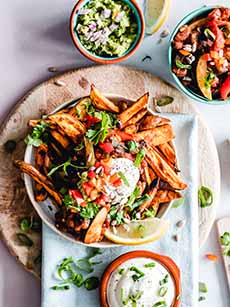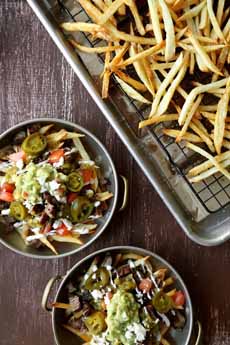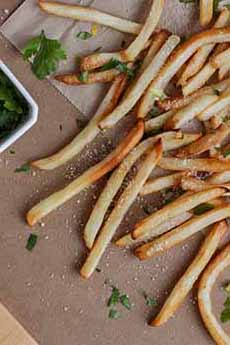Baked French Fries Recipe, a.k.a. Oven Fries (It’s National French Fry Day!)
|
What’s for dinner on July 13th, National French Fry Day? How about baked French fries—no need to deep-fat fry (which is our least favorite kitchen task). Fried potatoes have been around for thousands of years, since the ancestors of today’s Peruvians cooked wild potatoes over fire in oil. But what Americans call French fries began when Thomas Jefferson returned as the American Minister to France in 1789. He is credited with bringing French fries to America, but the truth is…not exactly. See the history of French fries below. Now for dinner: We don’t like to deep-fat fry at home, so we bake our fries (“baked fries” is an oxymoron, but it is what it is). We prefer to oven-bake over air-frying, but it’s a matter of individual taste. Here are tips from the Idaho Potato Commission to bake French fries that even Thomas Jefferson would enjoy. While this recipe is a basic one, the website has loads and loads of delicious potato recipes. > The history of French fries is below. > The different types of fries: More than 30! > The different types of potatoes. > The year’s 30 potato holidays. Regardless of your preparation method (deep-fry, air fry, baked), russet potatoes yield the best results. They are the variety of choice due to their low moisture content and smooth interior. Given that they also make the best baked potatoes, it’s no surprise that russets are the most popular variety of potatoes in the U.S. Ingredients For 4 Seervings 1. PLACE the sheet on the lowest rack of the oven. The heat at the bottom of the oven will provide a deeper roast on the fries, creating a crispier product. Preheat the oven to 400°F. If you have large rectangular baking dishes, you can use them to bake the fries for a potentially better result. Metal baking sheets can overheat quickly and provide an uneven, unpredictable baking experience for fresh-cut (as opposed to frozen) fries. 2. SLICE the potatoes lengthwise and then cut them into fry-shaped pieces, either julienne or baton. Make them the same size as much as possible for even cooking. 3. PLACE the potatoes in a bowl of cold water and let them soak for at least 20 minutes to some of the starch for maximum crispness. Drain and pat them dry thoroughly. Empty the bowl of water. 4. RETURN the potatoes to the bowl and toss with the oil until evenly coated. Season with salt. 5. SPREAD the potatoes on a baking sheet in a single layer. You might need two sheets so that the potatoes don’t touch. Line the baking sheet(s) with parchment paper for easier cleanup. 6. BAKE for 25-30 minutes, turning the fries after 15 minutes. Adjust the seasoning and serve hot with your dip of choice. According to Technomic, a consulting firm for the foodservice industry, the favorite dipping sauces for fries and onion rings are: The difference between Russian dressing and Thousand Island dressing is that the latter contains pickle relish, the little squares representing the Thousand Islands of upstate New York. Here’s the recipe. Fry sauce is essentially Russian dressing, a combination of ketchup and mayonnaise. Fry sauce is sometimes spiked with Tabasco or dried chili powder. Among his many stints in government service†, Thomas Jefferson sailed to Europe in 1784, to join John Adams and Benjamin Franklin in negotiating commercial treaties with European powers. He then succeeded Benjamin Franklin as American Minister to the Court of Versailles, serving from 1785 to 1789 (and later, as vice president and president of the United States). |
|
|
|
It’s not surprising that in five years he developed a taste for French food, and was exposed to other European cuisines, such as pasta during travels to Italy. While in France he had his slave James Hemmings trained in French cooking, and when they returned to the U.S., he is credited with serving French fries at Monticello. However, these potatoes weren’t called French fries. That term did not appear in print until 1856 in England when the expression “french fried potatoes” first appears in “Cookery for Maids of All Work” by Mrs. Eliza Warren, a British author of books for the housewife. (She writes: “French Fried Potatoes. Cut new potatoes in thin slices, put them in boiling fat, and a little salt; fry both sides of a light golden brown colour; drain.”) But decades earlier, across the pond, Jefferson returned to America from France with a recipe for “pommes de terre frites à cru en petites tranches,” which essentially translates to “deep-fried potatoes in small cuttings.” The recipe appears in his own handwriting. we know that an 1802 dinner in Jefferson’s White House (1801-1809) included “potatoes served in the French manner.” Read this article on The Thomas Jefferson Foundation website to see what other now-American food mainstays he brought back. This recipe for “pommes de terre frites à cru en petites tranches,” written in Jefferson’s own hand, referred to thin, shallow-fried slices of potato, not deep-fat fried as we know today’s French fries. The term was used in the U.S. as early as 1899, although it is not clear whether the reference is to conventional round potato slices or to julienne/baton shapes. The source material is an item in Good Housekeeping magazine which references “Kitchen Economy in France”: “The perfection of French fries is due chiefly to the fact that plenty of fat is used” [source]. It is not clear where or when the now-familiar deep-fried julienne slices and batons (fingers)* first appeared. By the early 20th century, the term “French fried” was being used in the sense of “deep-fried” for foods like onion rings or chicken [source]. But no matter where that date lies that brought forth crispy fingers of fries, today now more than 4.5 billion pounds of French fries are consumed in America each year. That’s roughly 13.5 pounds per person. You may have read that the name “French fries” was bestowed during World War I by the American Expeditionary Forces. Arriving in Belgium, they assumed that “frites” (fries), as they were called in French, were a French dish because French was spoken in the Belgian Army. But the term did not take hold for for decades after the end of the war in 1918. Another story is told by the Belgian journalist Jo Gérard, who claimed that a 1781 family manuscript recounts that potatoes were deep-fried prior to 1680 in Belgium’s Meuse Valley. He claims that frites were invented a substitute for frying fish when the rivers were frozen. Gérard never produced a manuscript to support this claim, and furthermore, the potato did not arrive in the region until around 1735. In any case, says Belgian food historian Pierre Leclerc, given 18th-century economic conditions, “it is absolutely unthinkable that a peasant could have dedicated large quantities of fat for [deep-frying] potatoes. At most they were sautéed in a pan.” Leclercq, who has traced the history of the french fry and asserts that “it is clear that fries are of French origin” (read the full story here). He recounts that frites became an emblematic Parisian dish in the 19th century. Frédéric Krieger, a Bavarian musician, learned to cook frites at a roaster on rue Montmartre in Paris in 1842. He brought the recipe to Belgium in 1844, where he would create a business, Fritz, to sell “la pomme de terre frite à l’instar de Paris,” or Paris-style fried potatoes. So was our modern style of fries born in Paris in the 1840s? Were Eliza Warren’s fries of 1856 these fries? Among other questions, the French and Belgians have an ongoing dispute about where fries were invented. Let the battle continue, as long as we get our fries! *Julienne strips resemble small matchsticks, typically 1/16-1/18 inch wide and 1 to 2 inches long. To cut julienne strips, first cut the vegetable into 1/16 or 1/8-inch-thick slices, then stack the slices and cut them into 1/16 or 1/8-inch-wide strips that are of the desired length. Batons (sometimes called batonnets) are larger matchsticks, typically 1/4 x 1/4 x 2 to 2 1/2 inches long. Use the same method as with julienne strips. †Member of the Virginia House of Burgesses 1769-1775; member of the Continental Congress, 1775-1776 and 1783-1784; CHECK OUT WHAT’S HAPPENING ON OUR HOME PAGE, THENIBBLE.COM.
|
||







